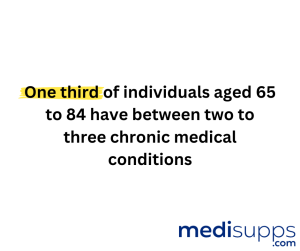
by Russell Noga | Updated October 9th, 2023
 As the bedrock of America’s healthcare system for seniors, Medicare faces a myriad of financial challenges in the coming years. With an aging population and rising healthcare costs, the program’s financial stability is a growing concern.
As the bedrock of America’s healthcare system for seniors, Medicare faces a myriad of financial challenges in the coming years. With an aging population and rising healthcare costs, the program’s financial stability is a growing concern.
In this article, we will delve into the intricacies of Medicare’s financial structure, explore the impacts of an aging population and the COVID-19 pandemic, and address the question, “Will Medicare be around in 5 years?”
We will also clarify the difference between insolvency and bankruptcy and discuss potential solutions to ensure Medicare’s long-term sustainability.
Short Summary
- Medicare is funded through a combination of sources, but faces financial strains due to increasing costs and an aging population.
- COVID-19 has had a negative effect on Medicare financing, prompting policymakers to explore potential solutions such as cost controls and value-based payment programs.
- Legislative efforts have been made to protect the program from insolvency, yet its long term outlook remains uncertain.
 Understanding Medicare’s Financial Structure
Understanding Medicare’s Financial Structure
Medicare, a vital lifeline for millions of seniors, is funded through a combination of general revenues, payroll tax revenues, and premiums paid by beneficiaries. The program’s financial structure can be divided into two trust funds: the Hospital Insurance (HI) trust fund, which supports Medicare Part A, and the Supplementary Medical Insurance (SMI) trust fund, which finances Medicare Parts B, C, and D.
Despite being an essential component of America’s healthcare system, Medicare faces financial strains, with its hospital insurance trust fund projected to be depleted by 2028. The increasing costs of healthcare and the necessary measures to address them will have a detrimental effect on seniors if Medicare and Medicaid services reform is not implemented.
The long-term outlook for Medicare financing and solvency is worrying, as the Social Security and Medicare programs may need to either reduce benefits for approximately 71 million Americans or increase taxes for future workers.
 Medicare Part A: Hospital Insurance Trust Fund
Medicare Part A: Hospital Insurance Trust Fund
Medicare Part A, which covers inpatient hospital care, hospice, and short-term stays in skilled nursing facilities or home healthcare services, is supported by the Hospital Insurance (HI) trust fund.
The primary source of funding for the HI trust fund is Medicare payroll taxes, but it also receives income from taxes paid on Social Security benefits, interest earned on its investments, and revenues from prescription drugs covered under Medicare Part D.
The HI trust fund is projected to expire in 2028, which may lead to an increase in Medicare premiums or other changes to maintain the program’s solvency. If healthcare expenses persistently exceed the money entering the Medicare Hospital Insurance trust fund, Medicare Part A could potentially finance only 90% of the costs it currently covers.
This raises concerns about the future of Medicare, as the aging population and increasing healthcare costs put immense pressure on the program’s financial stability.
 Medicare Parts B, C, and D: Supplementary Medical Insurance
Medicare Parts B, C, and D: Supplementary Medical Insurance
The Supplementary Medical Insurance (SMI) trust fund finances Medicare Parts B, C, and D, which cover outpatient services, medical supplies, Medicare Advantage plans, and prescription drugs. Unlike Part A, the SMI trust fund relies on general revenues and beneficiary premiums to cover costs.
Projected spending for benefits covered under Medicare Part B and Part D will result in an increased burden on general revenue funding and beneficiary premiums. This increased burden is expected to remain necessary in the future in order to cover any costs related to these parts of the program, as well as to maintain the stability of the Social Security trust funds.
Medicare Advantage plans, or Part C, are not financed separately. Funds for Part A benefits provided by Medicare Advantage plans are sourced from the Medicare HI trust fund, while funds for Part B and D benefits are sourced from the SMI trust fund.
As Medicare spending continues to grow, policymakers must explore effective solutions to ensure the program’s long-term sustainability.
Discover 2024 Plans & Rates
Enter Zip Code
The Aging Population and Its Impact on Medicare
The aging population has a significant impact on Medicare resources and funding. Approximately 8,000 to 10,000 Americans reach the age of 65 daily, with the percentage of the US population eligible for Medicare projected to reach 20% by 2030.
This demographic shift puts immense strain on the Medicare program and health care providers, as the program must adapt to accommodate the growing number of seniors who rely on it for their healthcare needs.
Chronic Medical Conditions and Rising Costs
The prevalence of chronic medical conditions among older adults is another factor contributing to increased utilization of medical resources and higher costs for Medicare. Approximately one-third of individuals aged 65 to 84 have between two to three chronic medical conditions, while slightly less than a quarter have four to five.
As the number of seniors with chronic health issues continues to rise, the demand for medical services and the associated costs will only grow, further straining Medicare’s financial resources.
With an aging population and the growing prevalence of chronic medical conditions, the financial pressures on Medicare are intensifying. Addressing these challenges will require innovative solutions and policy changes to ensure the program remains sustainable for future generations.
One such solution could involve the recommendations of the Medicare Payment Advisory Commission.
The Effect of COVID-19 on Medicare Financing
The COVID-19 pandemic has had a detrimental impact on Medicare financing, as payroll taxes have decreased and resources have been redirected to fight the pandemic. Traditional Medicare beneficiaries experienced a decrease in spending in 2020 due to reduced service utilization during the pandemic.
However, the additional costs associated with COVID-19 countermeasures will not deplete the Medicare Trust Fund.
Despite the challenges posed by the pandemic, Medicare remains a resilient program. Although COVID-19 has affected Medicare financing, it has not had a significant financial impact on the program overall.
Policymakers must continue to monitor the situation and implement appropriate measures to ensure Medicare’s long-term stability.
Insolvency vs. Bankruptcy: Understanding the Terms
When discussing Medicare’s financial challenges, it is important to understand the distinction between insolvency and bankruptcy.
Insolvency indicates a situation where Medicare does not have sufficient funds to cover its expenses, while bankruptcy implies a cessation of operations of the program. Medicare is projected to reach insolvency in 2026, which could lead to increased out-of-pocket costs for beneficiaries.
While insolvency is a significant concern, it does not mean that Medicare will cease to exist. Rather, it highlights the need for policymakers to implement measures to address the growing financial pressures on the program and ensure its long-term sustainability.
Potential Solutions to Ensure Medicare’s Sustainability
Various proposals have been suggested to ensure Medicare’s sustainability, including changes to eligibility age and benefits, raising payroll taxes, or introducing new tax revenue sources such as taxable payroll. However, these ideas are often controversial, as they may shift more costs onto seniors or require substantial changes to the structure of the program.
Ultimately, it is essential to implement policy changes to ensure the security of Medicare and its beneficiaries. Policymakers are actively exploring ways to address Medicare’s long-term solvency and sustainability challenges, such as:
- Finding evidence-based solutions to make Medicare more affordable and fiscally sustainable
- Implementing cost controls to reduce healthcare costs
- Exploring value-based payment programs and improved care delivery models
These measures are aimed at meeting the promises of Medicare while also ensuring its long-run sustainability.
Legislative Efforts to Protect Medicare
In order to safeguard Medicare, the Protecting Medicare and American Farmers from Sequester Cuts Act was enacted, and bipartisan legislation was introduced to protect physicians from pay cuts under Medicare.
Additionally, President Biden has expressed his commitment to protecting and strengthening Medicare, vowing to expand access to affordable healthcare, reduce prescription drug costs, and safeguard seniors from fraud and abuse.
These legislative efforts reflect a growing recognition of the need to protect Medicare from insolvency and ensure its long-term sustainability. As the healthcare landscape continues to evolve, it is crucial that policymakers remain vigilant and responsive to the needs of Medicare beneficiaries and the program as a whole.
Factors Influencing Medicare Trust Fund Solvency
A number of factors influence the solvency of the Medicare trust fund, such as legislative and regulatory modifications, utilization of services, and shifting economic conditions. The current status of Medicare’s solvency is concerning, with the Medicare Hospital Insurance Trust Fund projected to become insolvent by 2026.
Financial pressures from higher healthcare costs and an aging population are key challenges that Medicare faces in the long term. Addressing these issues will require a multifaceted approach that takes into account the various factors impacting the program’s solvency and seeks to implement effective and sustainable solutions.
Long-Term Outlook for Medicare Financing and Solvency
The long-term outlook for Medicare financing and solvency is uncertain, given the financial pressures from increasing healthcare costs and an aging population. The aging population is increasing the demand for healthcare services, resulting in a strain on Medicare’s finances due to the rising costs of medical care.
Policymakers may need to contemplate broader alterations to sustain the program, such as increasing taxes, decreasing benefits, or increasing the eligibility age.
As Medicare faces growing financial challenges, it is imperative for policymakers to prioritize the long-term sustainability of the program and ensure that it remains a cornerstone of America’s healthcare system.
Compare Medicare Plans & Rates in Your Area
Summary
In conclusion, the financial challenges facing Medicare are complex and multifaceted. With an aging population, rising healthcare costs, and the impact of the COVID-19 pandemic, the program’s long-term sustainability is uncertain.
However, through innovative solutions, legislative efforts, and a commitment to preserving the program for future generations, Medicare can continue to provide essential healthcare services to millions of Americans.
As we move forward, it is crucial that policymakers and stakeholders work together to address the financial pressures on Medicare and ensure its enduring role in America’s healthcare landscape.
Frequently Asked Questions
Will Medicare still exist in its current form five years from now (in 2028)?
Medicare is a vital program, and while changes may occur, it’s highly likely that it will still exist in some form in 2028.
What factors could potentially impact the future of Medicare over the next five years?
Various factors, including legislative changes, healthcare costs, demographic shifts, and economic conditions, can influence the future of Medicare.
Are there any pending legislative proposals that could affect Medicare’s future within the next five years?
Legislative proposals and reforms related to Medicare are possible, and their impact on the program’s future will depend on political decisions and public policies.
How can beneficiaries prepare for potential changes in Medicare over the next five years?
Beneficiaries can stay informed about healthcare policy changes, review their coverage options regularly, and adapt their plans as needed to ensure they receive adequate healthcare services.
What is the current financial stability of the Medicare program, and how might it change in the next five years?
Medicare’s financial stability can fluctuate due to factors such as healthcare cost inflation and the aging population. Regular assessments by Medicare trustees help monitor its financial health.
Are there concerns about Medicare’s ability to meet the healthcare needs of an aging population in the coming years?
The aging population is a challenge, but Medicare continually adapts to meet changing healthcare needs. Policy adjustments may be necessary to ensure sustainability.
How can the government ensure the long-term viability of the Medicare program for the next five years and beyond?
The government can consider various strategies, such as cost containment, revenue enhancement, and program reforms, to secure the future of Medicare.
What role might advancements in healthcare technology and delivery models play in the future of Medicare over the next five years?
Innovations in healthcare technology and delivery can improve efficiency and reduce costs, potentially benefiting Medicare and its beneficiaries.
Are there potential solutions or policy changes that could enhance Medicare’s effectiveness and accessibility over the next five years?
Policy changes could focus on improving preventive care, managing chronic diseases, and addressing disparities in healthcare access to enhance Medicare’s effectiveness.
How can individuals advocate for the preservation and improvement of Medicare over the next five years?
Individuals can advocate for Medicare by staying informed about healthcare policy, engaging with elected officials, participating in healthcare discussions, and supporting initiatives that align with their concerns and priorities.
Find the Right Medicare Plan for You
Finding the right Medicare plan doesn’t have to be confusing. Whether it’s a Medigap plan or you have questions about Medicare Advantage or Medicare Part D, we can help.
Call now at 1-888-891-0229, and one of our knowledgeable, licensed insurance agents will be happy to assist you!

Russell Noga is the CEO and Medicare editor of Medisupps.com. His 15 years of experience in the Medicare insurance market includes being a licensed Medicare insurance broker in all 50 states. He is frequently featured as a featured as a keynote Medicare event speaker, has authored hundreds of Medicare content pages, and hosts the very popular Medisupps.com Medicare Youtube channel. His expertise includes Medicare, Medigap insurance, Medicare Advantage plans, and Medicare Part D.



